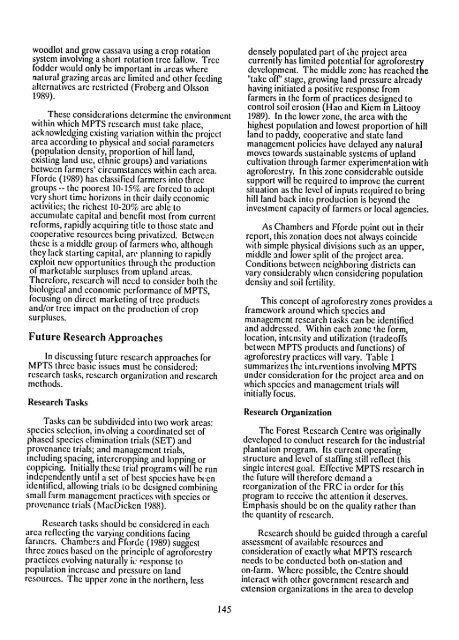multipurpose tree species research for small farms: strategies ... - part
multipurpose tree species research for small farms: strategies ... - part
multipurpose tree species research for small farms: strategies ... - part
You also want an ePaper? Increase the reach of your titles
YUMPU automatically turns print PDFs into web optimized ePapers that Google loves.
woodlot and grow cassava using a crop rotation<br />
system involving a short rotation <strong>tree</strong> fallow. Tree<br />
fodder would only be important in areas where<br />
natural grazing areas are limited and other feeding<br />
alternatives are restricted (Froberg and Olsson<br />
1989).<br />
These considerations determine the environment<br />
within which MPTS <strong>research</strong> must take place,<br />
acknowledging existing variation within the project<br />
area according to physical and social parameters<br />
(population density, proportion of hi! land,<br />
existing land use, ethnic groups) and variations<br />
between farmers' circumristances within each area.<br />
F<strong>for</strong>de (1989) has classified farmers into three<br />
groups -- the poorest 10-15% are <strong>for</strong>ced to adopt<br />
very short time horizons in their daily economic<br />
activities; the richest 10-20% are able to<br />
accumulate capital and benefit most front current<br />
re<strong>for</strong>ms, rapidly acquiring title to those state and<br />
cooperative resources being privatized. Between<br />
these is a middle group of farmers who, although<br />
they lack starting capital, are planning to rapidly<br />
exploit new opportunities through the production<br />
of marketable surpluses from upland areas,<br />
There<strong>for</strong>e, <strong>research</strong> will need to consider both the<br />
biological and economic per<strong>for</strong>mance of MPTS,<br />
focusing on direct marketing of <strong>tree</strong> products<br />
and/or <strong>tree</strong> impact on the production of crop<br />
surpluses.<br />
Future Research Approaches<br />
In discussing future <strong>research</strong> approaches <strong>for</strong><br />
MPTS three basic issues must be considered:<br />
<strong>research</strong> tasks, <strong>research</strong> organization and <strong>research</strong><br />
methods,<br />
Research Tasks<br />
Tasks can be subdivided into two work areas:<br />
<strong>species</strong> selection, involving a coordinated set of<br />
phased <strong>species</strong> elimination trials (SET) and<br />
provenance trials; and management trials,<br />
including spacing, intercropping and lopping or<br />
coppicing. Initially these trial programs will be run<br />
independently until a set of best <strong>species</strong> have bten<br />
identified, allowing trials to be designed combining<br />
<strong>small</strong> farm management practices with <strong>species</strong> or<br />
provenance trials (MacDicken 1988).<br />
Research tasks should be considered in each<br />
area reflecting the varying conditions facing<br />
farmcrs. Chambers and F<strong>for</strong>de (1989) suggest<br />
three zones based on the principle of agro<strong>for</strong>estry<br />
practices evolving naturally iv response to<br />
population increase and pressure on land<br />
resources. The upper zone in the northern, less<br />
145<br />
densely populated <strong>part</strong> of the project area<br />
currently has limited potential <strong>for</strong> agro<strong>for</strong>estry<br />
development. The middle zone has reached the<br />
"take off' stage, growing land pressure already<br />
having initiated a positive response from<br />
farmers in the <strong>for</strong>m of practices designed to<br />
control soil erosion (Hao and Kiem in Littooy<br />
1989). In the lower zone, the area with the<br />
highest population and lowest proportion of hill<br />
land to paddy, cooperative and state land<br />
management policies have delayed any natural<br />
moves towards sustainable systems of upland<br />
cultivation through farmer experimentation with<br />
agro<strong>for</strong>estry. In this zone considerable outside<br />
support will be required to improve the current<br />
situation as the level of inputs required to bring<br />
hill land back into production is beyond the<br />
investment capacity of farmers or local agencies.<br />
As Chambers and F<strong>for</strong>de point out in their<br />
report, this zonation does not always coincide<br />
with simple physical divisions such as an upper,<br />
middle and lower split of the project area.<br />
Conditions between neighboring districts can<br />
vary considerably when considering population<br />
density and soil fertility.<br />
This concept of agro<strong>for</strong>cstry zones provides a<br />
framework around which <strong>species</strong> and<br />
management <strong>research</strong> tasks can be identified<br />
and a dressed. Within each zone the <strong>for</strong>m,<br />
location, intcnsity and utilization (tradeoffs<br />
between MPTS products and functions) of<br />
agro<strong>for</strong>estry practices will vary. Table 1<br />
summarizes the intLrventions involving MPTS<br />
under consideration <strong>for</strong> the project area and on<br />
which <strong>species</strong> and management trials will<br />
initially focus.<br />
Research Organization<br />
The Forest Research Centre was originally<br />
developed to conduct <strong>research</strong> <strong>for</strong> the industrial<br />
plantation program. Its current operating<br />
structure and level of staffing still reflect this<br />
single interest goal. Effective MPTS <strong>research</strong> in<br />
the future will there<strong>for</strong>e demand a<br />
reorganization of the FRC in order <strong>for</strong> this<br />
program to receive the attention it deserves.<br />
Emphasis should be on the quality rather than<br />
the quantity of <strong>research</strong>.<br />
Research should be guided through a careful<br />
assessment of available resources and<br />
conside'ration of exactly what MPTS <strong>research</strong><br />
needs to be conducted both on-station and<br />
on-farm. Where possible, the Centre should<br />
interact with other government <strong>research</strong> and<br />
extension organizations in the area to develop

















